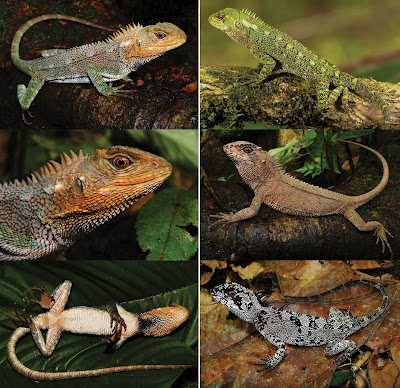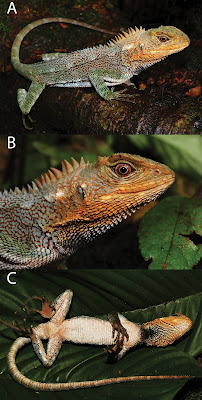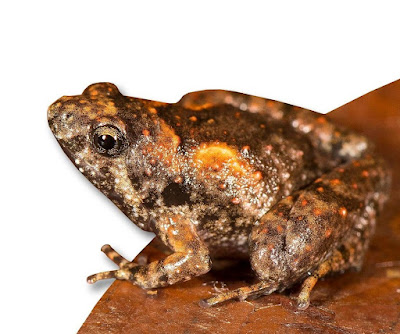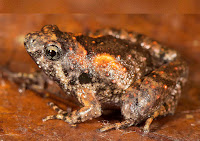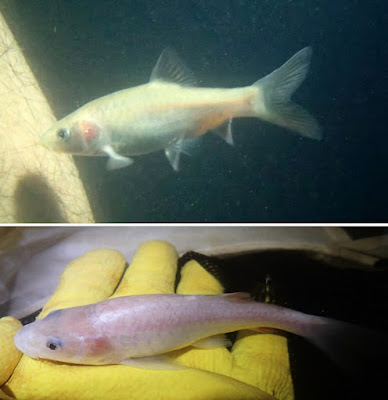[Most Recent Entries] [Calendar View]
Sunday, September 5th, 2021
| Time | Event | ||||
| 2:38p | [Herpetology • 2021] Enyalioides feiruzae • A New Species of Wood Lizard (Iguania: Hoplocercidae) from the Río Huallaga Basin in Central Peru
Abstract We report the discovery of a new species of Enyalioides from the premontane forest of the Río Huallaga basin in central Peru. The most similar and phylogenetically related species are E. binzayedi and E. rudolfarndti. However, the new species differs from E. binzayedi (state of character in parentheses) by having dorsal scales strongly keeled on paravertebral region and feebly keeled or smooth elsewhere (prominent medial keel on each dorsal scale), more dorsals in transverse row between dorsolateral crests at midbody 26–39, x̄ = 30.44 (22–31, x̄ = 27.57), and a conspicuous posteromedial black patch in the gular region of males (absent). Contrarily, adult males of the new species and E. rudolfarndti are readily distinguished by having a conspicuous posteromedial black patch in the gular region, absent in E. rudolfarndti, and by lacking a conspicuous orange blotch (faint if present) on the antehumeral region, as in E. rudolfarndti. We also present an updated molecular phylogenetic tree of hoplocercines, which strongly supports both referral of the newly discovered species to Enyalioides and its status as distinct from those recognized previously. Key Words: Andes, Enyalioides, Hoplocercinae, Huallaga River, new species, Peru, phylogeny Enyalioides feiruzae sp. nov. Diagnosis: Enyalioides feiruzae can be distinguished from other species of Enyalioides, except E. binzayedi and E. rudolfarndti, by the combination of the following characters (see also Table 1): (1) scales posterior to the superciliaries enlarged and pointed (relative to adjacent scales), forming a well-defined longitudinal row of distinctly raised scales across the lateral edge of the head in juveniles and adults of both sexes; (2) vertebral crest strongly projected, continuous, and decreasing in size posteriorly, with vertebrals on neck at least four times higher than those between hind limbs; (3) projecting scales on body or limbs absent; (4) ventral scales strongly keeled; (5) caudal scales heterogeneous in size on each autotomic segment; and (6) superciliary triangular flap that projects posterolaterally over each eye absent. The most similar species to Enyalioides feiruzae is its sister species (see below) E. rudolfarndti (Fig. 4B). Both species are similar in dorsal coloration, scale counts, and size; however, E. feiruzae differs from E. rudolfarndti (character states in parentheses) in having a conspicuous posteromedial black patch, rarely dark brown, in the gular region in both sexes (absent); adult males usually without an orange round blotch on the antehumeral region or a faint blotch if present (conspicuous orange blotch on antehumeral region in adult males); scales on flanks homogeneous in size (distinctly heterogeneous); and fewer supralabials 8–10, x̄ = 9.52 (11–12, x̄ = 11.75). The new species differs from E. binzayedi in having dorsal scales strongly keeled on paravertebral region and feebly keeled or smooth elsewhere (prominent medial keel on each dorsal scale); fewer supralabials 8–10, x̄ = 9.52 (11–15, x̄ = 12); more dorsals in transverse row between dorsolateral crests at midbody 26–39, x̄ = 30.44 (22–31, x̄ = 27.57); and a conspicuous posteromedial black patch in the gular region (absent).
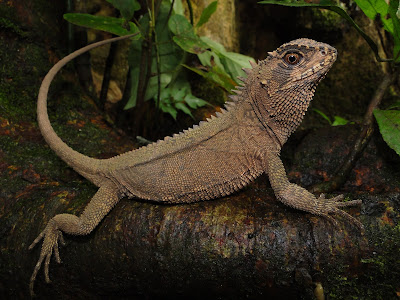 Etymology: The specific name is a noun in the genitive case and is a patronym for Feiruz, a female green iguana, muse and lifelong friend, owned by Catherine Thomson from Farmington Hills, Michigan, USA, who supported our taxonomic research and nature conservation through the BIOPAT initiative. Pablo J. Venegas, Germán Chávez, Luis A. García-Ayachi, Vilma Duran and Omar Torres-Carvajal. 2021. A New Species of Wood Lizard (Hoplocercinae, Enyalioides) from the Río Huallaga Basin in Central Peru. Evolutionary Systematics. 5(2): 263-273. DOI: 10.3897/evolsyst.5.69227 | ||||
| 2:42p | [Herpetology • 2021] Micryletta sriwijaya • A Tiny New Species of Microhyla Tschudi, 1838 (Anura: Microhylidae) from Belitung Island and Southeastern Sumatra, Indonesia
Abstract A tiny new species of narrow-mouthed frog of the genus Microhyla is described from the island of Belitung and southeastern Sumatra, Indonesia. The most distinctive feature of the new frog is its diminutive adult size, snout-vent length ranging only from 12.3 to 15.8 mm in adult males. Phylogenetic analyses based a fragment of the mitochondrial 16S rRNA gene, along with detailed morphological and acoustic comparison differentiate the new taxon from all known congeners. The new species, formally described as Microhyla sriwijaya sp. nov., is a member of the M. achatina species group and the sister taxon to M. orientalis. It is diagnosable from other congeners by a combination of characters: (1) smaller male snout-vent size < 16 mm; (2) snout obtusely rounded in dorsal view; (3) absence of mid-dorsal line and skin fold; (4) first finger reduced (finger I length less than half of finger II length); (5) dorsum with a prominent dark median mark extending posteriorly, narrow anteriorly near the level of the shoulder and expanding dorsolaterally up to the vent; margins of the dorsal marking concave with broad reddish-brown or orange colouration on either side; (6) foot webbing rudimentary, reaching just up to the first subarticular tubercle on all toes; (7) dorsal skin with prominent tubercles, especially in life; (8) tibiotarsal articulation of adpressed limb reaching beyond the snout tip; and (9) males produce a single type of call with pulsatile temporal structure, calls of relatively short duration ranging between 31.8–62.8 s, with two to three pulses delivered at a rate ranging between 32.2–36.0 pulses per second, and the mean overall dominant frequency of 4.3 kHz. The uncorrected pairwise genetic distances between Microhyla sriwijaya sp. nov. and all other known congeners are > 3.8% for the studied 16S gene fragment. The new species was discovered from wayside rural areas with oil palm plantations at four localities in the small island of Belitung (type locality), and from coffee plantation and secondary forest at Lampung in southeastern Sumatra. It is not known from any protected area and appears to be threatened due to tin mining activity, intensive logging, oil palm, and other commonly practiced agriculture activities. Keywords: Amphibia, Bioacoustics, Integrative Taxonomy, Microhyla achatina group, Mitochondrial DNA, new species, Phylogeny, Southeast Asia Microhyla sriwijaya Rury Eprilurahman, Sonali Garg, Vestidhia Y. Atmaja, Farits Alhadi, Misbahul Munir, Rosichon Ubaidillah, Tuty Arisuryanti, S. D. Biju, Eric N. Smith and Amir Hamidy. 2021. A Tiny New Species of Microhyla Tschudi, 1838 (Amphibia: Anura: Microhylidae) from Belitung Island and Southeastern Sumatra, Indonesia. Zootaxa. 5027(4); 451-488. DOI: 10.11646/zootaxa.5027.4.1 | ||||
| 2:48p | [Ichthyology • 2021] Barbodes pyrpholeos • A New Species, the First Cave-dwelling Cyprinid Fish (Cypriniformes: Cyprinidae) in the Philippines, with Redescription of B. montanoi
Abstract Barbodes pyrpholeos, new species, is the first cave-dwelling cyprinid fish reported from the Philippines. It is described from karst systems in Mindanao. It is distinguished from other congeners by having a poorly pigmented body with reddish fins in combination with a smooth dorsal-fin spine without serrations, and several additional morphological characters. It differs from the Indonesian troglobitic congener Barbodes microps by the presence of eyes, and a narrower body amongst other characters. Barbodes montanoi, a putative close relative of the new species, is redescribed based on recently collected material. Key words. troglobite, Cyprinidae, biodiversity, new species, Southeast Asia Barbodes pyrpholeos, new species Diagnosis. Barbodes pyrpholeos can be differentiated from all congeners by the following unique combination of characters: body with little brown pigment, appearing white or pinkish in life; unpaired fins with posterior half bright orangey-red in life, anterior half of unpaired fins and paired fins hyaline; eyes present and pigmented, possibly still functional. All other congeners (except the cave-dwelling B. microps) having body with black blotches, bars, stripes, dots, and triangular markings; body and fins appear pigmentless in B. microps (information on colours in life not available). Barbodes pyrpholeos can be further differentiated from B. microps (some data obtained from Haryono, 2006) in having the following characters: eye present, though variable in size (based on available material only) vs. eye absent or represented by a small, possibly non-functional eye in some individuals of B. microps; more dorsal-fin rays (8–9½, vs. 8); greater mean head length (32.3% SL, vs. 30.8%); lower mean predorsal length (55.1% SL, vs. 57.5%); lower mean body depth at anus (20.6% SL, vs. 36.5%); lower mean caudal peduncle depth (12.4% SL, vs. 14.7%); larger eye diameter (14.9–22.3, mean 17.3% HL, vs. 10.2–17.9, mean 14.9, when present). Distribution. Known only from karstic cave systems in Mindanao Island, the Philippines. Field notes. See Larson & Husana (2018: 98, fig. 1) and Husana (2020) for view of the habitat and syntopic species. Barbodes pyrpholeos was originally discovered by Arnel Pasilan (Prosperidad Mountaineering Club) during their earlier exploration, and brought to the attention of the second author. Etymology. The species name is a combination of the Greek words pyr, meaning fire, and pholeos, meaning cave, in reference to the fiery red fins of this cave-dwelling species. Used as a noun in apposition. Tan Heok Hui and Daniel Edison M. Husana. 2021. Barbodes pyrpholeos, New Species, the First Cave-dwelling Cyprinid fish in the Philippines, with Redescription of B. montanoi (Teleostei: Cyprinidae). RAFFLES BULLETIN OF ZOOLOGY. 69; 309–323. DOI: 10.26107/RBZ-2021-0054 |
| << Previous Day |
2021/09/05 [Calendar] |
Next Day >> |
